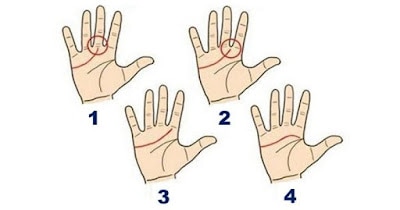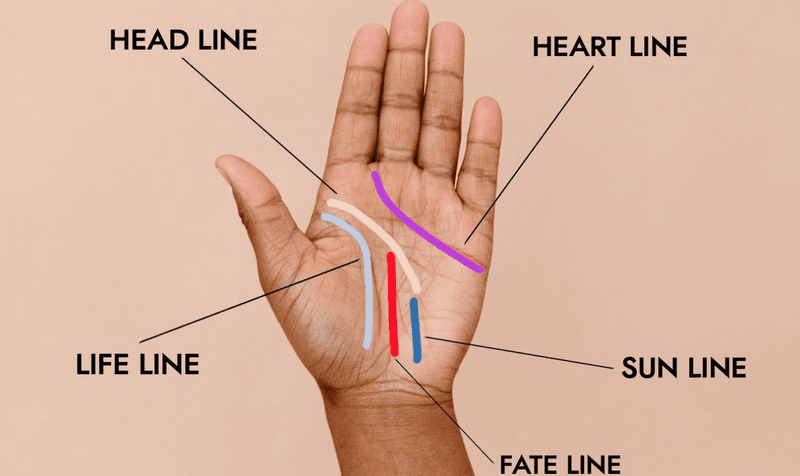What is a heart (love) line – What it Means if You Have It!

For hundreds of years palm readers have examined hands in order to predict a person’s fortune. As it turns out, they may not have been entirely wrong as the human hand contains a wealth of information.
What is a heart (love) line
The heart line, also known as the love line, is one of the three major lines found on the palm of the hand in the field of palmistry. It is the horizontal line that runs across the upper part of the palm, just below the fingers. The heart line is said to represent a person’s emotional and romantic nature and can give insight into their emotional and love life.
Palmists believe that the shape, length, and depth of the heart line can indicate various aspects of a person’s emotional life, such as their capacity for love and relationships, their emotional stability, and their level of self-awareness.
Short line
A short, shallow heart line is said to indicate a lack of emotional depth or a lack of interest in relationships, while a long and deep heart line is said to indicate a strong emotional nature and a capacity for deep and meaningful relationships.
Curved line
A curved heart line is said to indicate a romantic and emotional person, while a straight line is said to indicate a more practical and reserved person. A broken heart line is said to indicate emotional turmoil or a history of broken relationships.
When it comes to palm lines, not all people are the same. Apart from the four major lines, some people have a short arched line under their middle and ring finger. In fact, this small curved line can even make a whole circle or two shorter separate lines. It’s commonly known as the Venus’s circle or love belt.
How to Read which Heart Line is yours?
1) If this is your heart line, you’re intelligent, ambitious, and independent. Plus, you can make good judgement and decisions. However, you may have a selfish, materialistic attitude in life. Take advantage of your good qualities to improve your communication and life.
2) If this is your heart line, you’re considerate, kind, and trustworthy with people. You are prone to getting too emotionally involved. It’s important to know when to keep off guard.
3) If this is your heart line, you are content and confident in your love life, no matter if you’re single or in a relationship. You’re happy either way.
4) If this is your heart line, you’re patient, caring, calm, warm-hearted and full of good intentions. You’re the altruistic type.
Did not find?
In case this line is not on your palm, don’t be disappointed as it is usually associated with people who are very sensitive and inclined to love problems. According to palm readers, if the circle is closed, it means a great love disappointment.
But, in case you have this circle, it’s best for you view failed relationships as life lessons rather than fatal disappointments. If the line forms a semi-circle, it implies love difficulties that will be overcome some time in a person’s life.
Several semi-circled lines, one beneath another, mean that you are really emotional.
The heart line, one of the four major palm lines, begins just under the middle finger and ends under the small finger.
Origins of Palm Reading
The origins of palm reading, also known as palmistry or chiromancy, can be traced back to ancient civilizations such as India, China, and Egypt. The practice of reading the lines on the palm of the hand to gain insight into a person’s character, personality, and future has been a part of various cultures for thousands of years.
In ancient India, palmistry was known as hasta rekha shastra and was considered one of the 64 arts that a person should master in order to live a well-rounded life. The study of palmistry was also prevalent in ancient China and was known as chirognomy.
In ancient Egypt, palmistry was considered a sacred practice and was used to predict the future and to determine a person’s suitability for different roles in society.
It’s difficult to say who exactly “invented” palm reading, as it’s a practice that has evolved over thousands of years across different cultures and civilizations. However, the earliest known text on the subject is the “Chiromancy” book of the “Five Arts” of the “Hand” written by I-Ching in 2800 BC in ancient China.
Palmistry has been passed down through the generations, and it’s still a popular practice today, although it’s considered more of an art and less of a science, it’s not considered a reliable method for predicting the future or understanding someone’s personality or character.
Disclaimer!
Palmistry is not a science and should not be used as a diagnostic tool. The interpretation of the heart line and other lines on the palm can vary depending on the individual and the palm reader, and should not be considered as a substitute for professional medical or psychological advice.









